- Lesson One: The Number One
- ... in Geometry
- ... in Nature
- ... in Culture
- "Uroboros" (related artwork by the author)
- "Creation" (related artwork by the author)
- Lesson Two: The Square Root of Two
- ... in Geometry
- ... in Nature, Part 1
- ... in Nature, Part 2
- ... in Culture, Part 1
- ... in Culture, Part 2
- "Duality" (related artwork by the author)
- Lesson Three: The Square Root of Three
- ... in Geometry
- ... in Nature
- ... in Culture
- "Vesica" (related artwork by the author)
- Lesson Four: Phi, or the Golden Proportion
- ... Intro, Part 2
- ... Intro, Part 3
- ... in Geometry
- ... in Nature
- ... in Nature, Part 2
- ... in Culture
- "The Flower of Phi" (related artwork by the author)
- Lesson Five: The Five Perfect Solids
- ... Intro, Part 2
- ... The Tetrahedron
- ... The Octahedron
- ... The Cube
- ... The Icosahedron
- ... The Dodecahedron
Before we get into how nature uses the proportion Phi, let's take a look at some of the geometric shapes that generate and can be generated by Phi. We'll be looking at a few distinct (yet related) items here, including the regular pentagon, Golden Rectangles, Golden Spirals, and a series of numbers known as the Fibonacci Series.
The reader may have been confused in the Introduction to Phi by the alternate use of either 0.618 or 1.618 for the value of Phi - after all, it would seem that the number must have a specific value. As such, we need to explain why it is acceptable to take either 1.618... or 0.618 as the value of Phi. The answer is quite simple: in our proportion A:B::B:(A+B), if we assume the totality (A+B) to equal 1, then the dividing point (the Golden Division) between A and B falls at 0.618... However, if we assume that the dividing point falls at 1, then the totality (A+B) must measure 1.618...
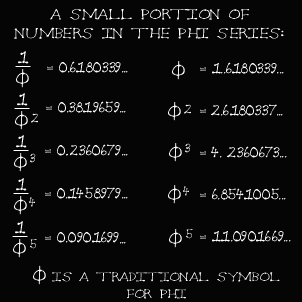 Original artwork created by A. O'Connor for Nature's Word using Adobe Photoshop 5.0.
Original artwork created by A. O'Connor for Nature's Word using Adobe Photoshop 5.0.Also, if we divide 1 by 1.618..., our answer reads 0.618... Thus, 1 over Phi (1.618...) gives us 0.618..., and as such 0.618... would be considered a fraction within the exponential series of Phi. As with any of the transcendental proportions in sacred geometry, any number that falls in the exponential series of a given transcendental proportion can be considered expressive of the original proportion itself. The reasons for this become clear when the student works with compass and straightedge to generate the transcendental proportion, as it is discovered that the exponential series of the proportion is automatically implied by the geometric figures which generate the original proportion.
As a direct example, and one that leads us to our very next topic, let us take a look at the number five and its geometric implications.
The number five and the proportion Phi are very closely intertwined - so much so that it can be said that in a geometric sense, five implies Phi automatically. Let's take a look at a regular pentagon to find out why:
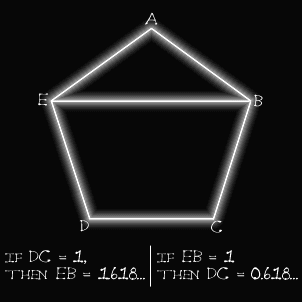 Original artwork created by A. O'Connor for Nature's Word using Adobe Photoshop 5.0.
Original artwork created by A. O'Connor for Nature's Word using Adobe Photoshop 5.0.Note that if the edge of the pentagon (for this example let's use line DC) is considered to equal 1, then line EB measures 1.618..., or Phi.
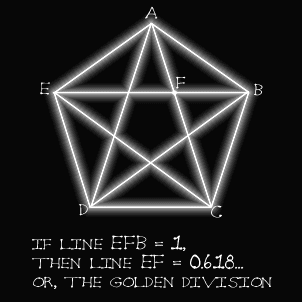 Original artwork created by A. O'Connor for Nature's Word using Adobe Photoshop 5.0.
Original artwork created by A. O'Connor for Nature's Word using Adobe Photoshop 5.0.In a regular pentagram (five pointed star), if Line EFB is taken to equal 1, then point F divides the Line EB at 0.618...
 Bruce Rawles' diagram reworked by A. O'Connor using Adobe Photoshop 5.0. Taken From: Bruce Rawles Sacred Geometry Homepage ( http://www.intent.com/sg/index.html)
Bruce Rawles' diagram reworked by A. O'Connor using Adobe Photoshop 5.0. Taken From: Bruce Rawles Sacred Geometry Homepage ( http://www.intent.com/sg/index.html)This image shows us a large pentagram with various lines defined within it simply by connecting the major points of intersection of the star. If we look closely at each "leg" of the star, we can see that there are a series of gradually diminishing pentagons, each of which contains a five pointed star. Once again, we find that the edge length of each pentagon relates to the next greater pentagon by 0.618... (or relates to the next smaller pentagon's edge length by 1.618...).
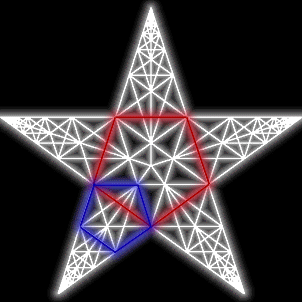 Bruce Rawles' diagram reworked by A. O'Connor using Adobe Photoshop 5.0. Taken From: Bruce Rawles Sacred Geometry Homepage ( http://www.intent.com/sg/index.html)
Bruce Rawles' diagram reworked by A. O'Connor using Adobe Photoshop 5.0. Taken From: Bruce Rawles Sacred Geometry Homepage ( http://www.intent.com/sg/index.html)In other words, if we take the edge length of the red pentagon in the middle of the star and multiply it by 0.618..., we find that the answer matches up with the edge length of the blue pentagon. We can then multiply the blue pentagon's edge length by 0.618..., and we find that the answer matches the edge length of the next smaller pentagon. The process can continue to infinite in theory without ever actually reaching the final point of the star.
As these examples show, it is impossible to create a regular pentagon or pentagram and not automatically imply the Phi proportion and the exponential series of numbers within the Phi series. Every object portraying a five pointed star is practically screaming the Phi proportion at the onlooker, whether they are consciously aware of the fact or not.
If we wish to generate a line measuring Phi from a perfect square, we can do so by the following method:
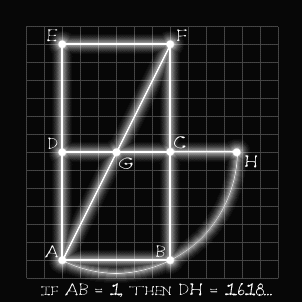 Original artwork created by A. O'Connor for Nature's Word using Adobe Photoshop 5.0.
Original artwork created by A. O'Connor for Nature's Word using Adobe Photoshop 5.0.1. Draw a perfect square ABCD
2. Draw a second perfect square CDEF adjacent to the first, sharing
Line CD with Square ABCD
3. Draw a diagonal from Point A to Point F, cutting Line CD at
G (note that if any side of one of the squares is taken to measure 1,
then Line AF measures the transcendental square root of five)
4. Extend Line DC a good distance past Point C
5. Set your compass point at G and extend its radius to Point
A. Keeping the compass point at Point G, bring the curve from Point
G to where it crosses the extended Line DC. Label the point where
the arc crosses CD Point H. If we assume that any side of our perfect
squares is equal to 1, then Line DH measures 1.618..., or Phi.
Here's why:
If Line DC measure's 1, then Line DG measures 0.5 (Line AF cuts Line CG exactly in half). As stated, because we are assuming the sides of our perfect squares are equal to 1, we can safely say that Line AF measures the square root of five, or 2.236... By setting our compass arc to the length of Line GA and adding this distance to Line DG, we are adding 1/2 of the square root of five to Line CG (GA must measure one half of the square root of five). Thus we have the length of DG (which, as stated, measures 0.5) plus 1/2 of the square root of five (one half times the square root of five equals 1.118...), or: 0.5 + 1.118 = 1.618...
It is of prime importance that the reader understand the above geometric exercise if any of the following geometric examples are going to make sense. Please, if possible, take a compass and straightedge and perform the exercise yourself. Repeat it if necessary in order to ensure total understanding of how and why the proportion of any side of the squares to Line CH equals 1.618...
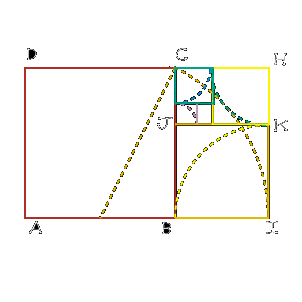 Original artwork created by A. O'Connor for Nature's Word using Adobe Photoshop 5.0.
Original artwork created by A. O'Connor for Nature's Word using Adobe Photoshop 5.0.By continuing with the above exercise, it is a simple matter to extend Line AB and cut it at Point I so that Line AI measures Phi as well. By connecting Points H and I we generate what is known as a Golden Rectangle, that being a rectangle whose sides relate to each other in the proportion of 1:1.618... In the case of our example at left, in Rectangle AIHD, if we took sides AD and IH to measure 1, then sides AI and HD measure 1.618...
What is particularly amazing about Golden Rectangles is that if we look at our Rectangle AIHD, we find that Rectangle BIHC is also a Golden Rectangle. In other words, if we took sides BI and HC to measure 1 in Rectangle BCIH, then sides IH and CB measure 1.618... By using our compass we can use the short edge length of BI (yellow arc) to create a perfect square within Rectangle BIHC, leaving a smaller rectangle JKHC - also a Golden Rectangle. The process can be continued for infinity (if one could draw that small), forever generating smaller Golden Rectangles within Golden Rectangles.
It is important to note that as the rectangles form within one another in the particular way shown above they turn by 90 degrees relative to the next larger rectangle. This spiraling effect leads to what is known as a "Golden Spiral" in the following manner:
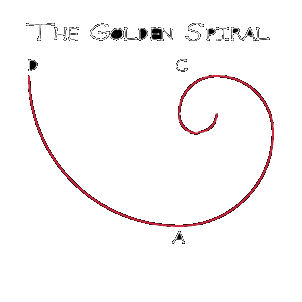 Original artwork created by A. O'Connor for Nature's Word using Adobe Photoshop 5.0.
Original artwork created by A. O'Connor for Nature's Word using Adobe Photoshop 5.0.Take a compass and set its point in the corner of the largest perfect square (Point C). Set its arc to the edge length of the square (CD), and draw a curve from one corner to the other (from Point D to Point A). Now move the compass point to the next smaller perfect square, set its arc to the smaller square's edge length, and draw an arc from corner to corner. Repeat the process as far as is feasible using the materials that you have at your disposal, knowing that the process could be repeated for infinity if it were possible to draw on such a scale.
The thing that sets the Golden Spiral apart from other spirals is the fact that its curve is exactly the same, no matter how smaller or how large a section we choose to view. In other words, if we were to zoom in to the infinitely small center of the Spiral, we would find an exact duplicate of what we would see if we were to zoom out to view an infinitely large Spiral. No other spiral can be mathematically produced (or produced any other way, for that matter) that adhears so closely to this similarity within similarity.
Those who are familiar with the comparably recent mathematical constructions known as "fractals" may be noticing a congruence between them and the discussion of Phi up until this point. The connection is not to be missed, because it speaks to one of the very fundamental ideas within the number Phi. That idea has been known in some circles as "microcosm / macrocosm theory," or the basic idea that we find exact replicas of the processes which affect the most minute of all things affecting the largest of all things in an exactly similar proportionate manner - from the atom, and smaller, to the universe, and larger. The exact similarity of the continually diminishing pentagons in a five pointed star; the same direct proportional relation between a Golden Rectangle and the infinitely diminishing Golden Rectangles within it (not to mention the infintely expanding Golden Rectangles encompassing it); the same principle of true proportional similarity on any scale found in the Golden Spiral - all are pointing the observer towards the idea that there are unifying principles that lie behind the universe that links together each and every level of perception.
In this way, Phi is simply the mathematical term that most directly expresses the possibility of a single unifying principle that ties together a continually unfolding and expanding reality, ranging from the infinitely minute to the incomprehensably vast. There is no other number that can claim to express this idea with such concise directness. To bring us back to the various topics discussed in the introduction to this frankly astounding proportion, let us not forget that the number not only connects the tiny to the vast, but does so in such a manner that expresses nothing short of transcendence and egolessness - in other words, a continual relation of the part directly to the whole that encompasses it - throughout infinite expansion and contraction.
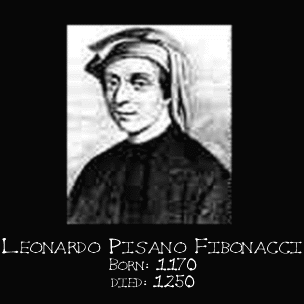 Taken From: CREDITS MISSING
Taken From: CREDITS MISSINGTo wrap up our discussion of Phi in geometry, let us take a look at the series of numbers known as the Fibonacci Series. This sequence of numbers is generated so simply that the series might be initially overlooked as the work of a simpleton. But Leonardo Pisano Fibonacci (1170-1250), the "discoverer" of this series and for whom it was named, was no simpleton. In fact, he was an Italian who travelled in and was educated in Africa just before 1200. Upon his return to Europe, he published a book entitled "Liber Abaci" (The Book of Computation, published 1202), which is credited with convincing all of Europe to switch from the cumbersome Roman numeral system to the Hindu-Arabic decimal system that we still use today. Besides learning of the Hindu-Arabic system of numbers, evidently Fibonacci learned something else from Europe's neighbors to the south - that being, of course, nothing other than the "Fibonacci" sequence, which also was presented for the first time to European eyes and minds in "Liber Abaci."
To begin this self-replicating series of numbers, all one need do is start with at the begining of number itself - the number one. It is the nature of this self-replicating numerical sequence to take two prior numbers and add them together to generate the following number. In this case, we have only the number one, so we repeat it a second time, giving us our first pair:
1,1
We add these two numbers, the result of which is of course 2. Two becomes the third number in our series:
1,1,2
Now we take our last two numbers and add them together to generate the fourth number, much as we added the first and second interger to obtain the third:
1,1,2,3
Adding out last two intergers again, we obtain 5, making the sequence thus far 1,1,2,3,5. 3 + 5 gives us 8, which is our sixth interger. 5 + 8 = 13, etc., etc., etc. The series continues for infinity, with a new number always being the product of the two numbers that immediately proceed it:
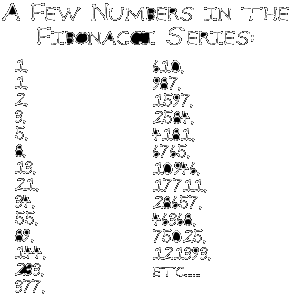 Original artwork created by A. O'Connor for Nature's Word using Adobe Photoshop 5.0.
Original artwork created by A. O'Connor for Nature's Word using Adobe Photoshop 5.0.So - very clever. But so what? Well, if we take any two adjacent numbers in the series and divide the smaller into the larger, we find that the result very nearly approximates the exact infinite value of Phi. Near the beginning of the series the values only generally approximate Phi, but we find that they approximate Phi with increasing accuracy the higher we progress into the series until it is uncanny how accurate they become.
Let's take a look at a few examples, just to make this point clear. At the low end of the scale, the series is far too general to derive any conclusive evidence that the Fibonacci series of numbers are anything seperate from any other mathematically generated series of numbers:
1 divided by 1 = 1
2 divided by 1 = 2
3 divided by 2 = 1.5
5 divided by 3 = 1.666
8 divided by 5 = 1.6
13 divided by 8 = 1.625
As stated, no big deal there - the numbers do happen to come out to 1.6 or thereabouts with the last three divisions - but this could simply be a coincidence. Let's continue:
21 divided by 13 = 1.615384
34 divided by 21 = 1.619047
55 divided by 34 = 1.617647058823529411
89 divided by 55 = 1.618
144 divided by 89 = 1.61797752808988764044943820224719...
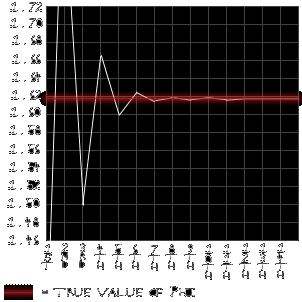 Original artwork created by A. O'Connor for Nature's Word using Adobe Photoshop 5.0.
Original artwork created by A. O'Connor for Nature's Word using Adobe Photoshop 5.0.The grid at right shows the alternation rather clearly. The numbers along the bottom axis are the sets of Fibonacci numbers that are divided into one another, i.e., "1st" represents the value produced by dividing the first two numbers from the series. The red line cutting horizontally across the graph represents the true value of Phi. It can easily be seen that by only the 7th set of intergers quotient of the dividing process is extremely close to Phi. By the 12th set of numbers the value is so close that we cannot even decern the alternation from the value of Phi itself. Of course, as already stated, the values never match Phi exactly, but instead continue to alternate from slightly lower to slightly higher than the true value, forever coming closer and closer without ever matching exactly.
Just to drive the point home, let's take a look at the result of dividing the 19th number in the Fibonnaci sequence into the 20th number, and compare it to a fairly exact value of Phi:
6765 divided by 4181 = 1.618033963...
Phi = 1.618033988...
Considering how accurate the quotient is by only the 19th and 20th numbers in a series of numbers that can be generated in a like manner for eternity, it is fairly safe to say that the Fibonacci series has a rather direct relation to the number Phi. It is no coincidence that we find the smallest numbers in the series are linked to one another by the exact same process as the higher (that process being the addition of the two prior numbers in the sequence to obtain the following number), and that the process just happens to automatically imply Phi by it's very nature. Once again, Phi has spoken it's message loud and clear: that it is the only number that can express continuous and constant relation through infinite growth and expansion as succinctly as it does.
Now, let's finally get to perhaps the grandest coincidence of all - that being that it would seem that Nature loves Phi even more than the most devout student of sacred geometry ever could.


